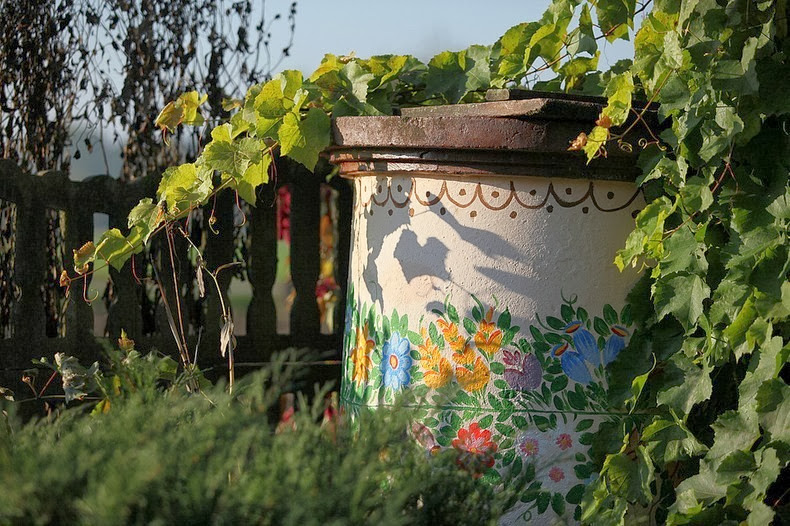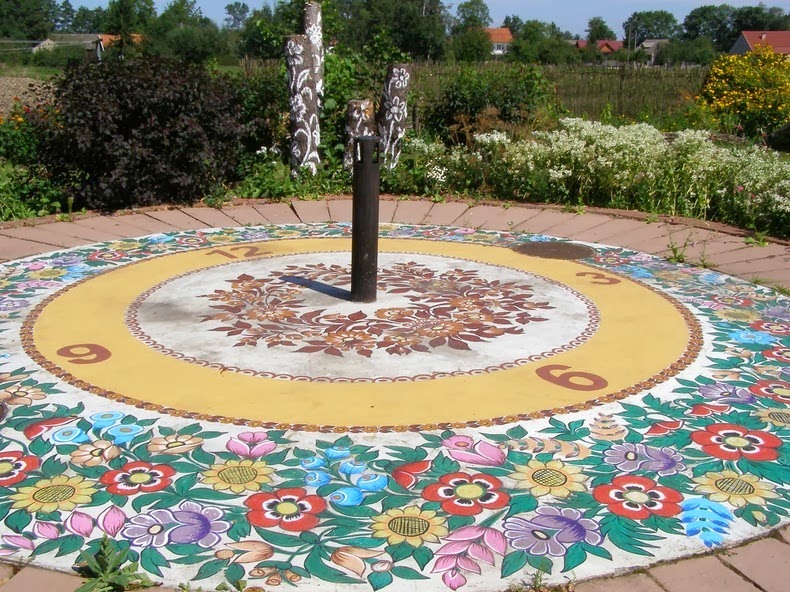Zalipie, The Painted Village

Zalipie is a village in southeastern Poland, 68 km east of the regional capital Kraków, known for its wonderfully painted houses.
The tradition of decorating both the exterior and the interior of houses originated at the end of the 19th century when old-fashioned furnaces were replaced with new furnaces with chimneys. Early furnaces had little more than a hole in the ceiling for smoke to escape, which being inadequate led to blackening of the walls by soot.
In order to cover the unsightly walls the women of the houses began painting over the spots of soot with whitewash. Later, these whitewashed walls became backdrops for more immaculate designs. Using flower compositions, the women put special emphasis on decorating the wide stoves. They also painted flower garlands under pictures and around windows and doors. Soon they began to paint the exterior of their homes and pretty much anything unmovable – chicken coups, bridges, bins, wells and dog kernels.
Photo credit
Initially, the ornamentation was predominantly geometric with dots, curves, circles, zig-zags, and wavy lines etc. and the materials used were simply those that were most available like brown clay, soot, and lime. As an adhesive they used milk, sugar and egg whites or dumpling stock. Brushes were composed of horse hair, leather, or human hair; some of these types of brushes were still used up until a several years ago.
Like most small villages, Zalipie would have gone unnoticed if it wasn’t for a clerk from Krakow, who became so intrigued by the Zalipian cottages that he published an article about them in a local ethnographic periodical in the year 1905.
The tradition is upheld each year in the first week after the Feast of Corpus Christi, when a competition is held for the most beautifully decorated cottage. The house-painting competition started in 1948 and occurred every few years until 1965 when it became an annual event. In addition to Zalipie, these special cottages can be found in a number of surrounding villages such as Kuzie, Niwka and Kłyż.
Zalipie’s best known painter was Felicja Curyłowa (1904–74), and since her death her three-room farmhouse has been turned into a museum.
Zalipie, The Painted Village

Photo credit
Zalipie, The Painted Village

Photo credit
Zalipie, The Painted Village

Photo credit
Zalipie, The Painted Village

Photo credit
Zalipie, The Painted Village

Photo credit
Zalipie, The Painted Village

Photo credit
Zalipie, The Painted Village

Photo credit
Zalipie, The Painted Village

Photo credit
Zalipie, The Painted Village

Photo credit
Zalipie, The Painted Village

Photo credit
Zalipie, The Painted Village

Photo credit
Zalipie, The Painted Village

Photo credit
Zalipie, The Painted Village

Photo credit

Photo credit

Photo credit
Sources: Visit Krakow, Lonely Planet, Kuriositas

Zalipie is a village in southeastern Poland, 68 km east of the regional capital Kraków, known for its wonderfully painted houses.
The tradition of decorating both the exterior and the interior of houses originated at the end of the 19th century when old-fashioned furnaces were replaced with new furnaces with chimneys. Early furnaces had little more than a hole in the ceiling for smoke to escape, which being inadequate led to blackening of the walls by soot.
In order to cover the unsightly walls the women of the houses began painting over the spots of soot with whitewash. Later, these whitewashed walls became backdrops for more immaculate designs. Using flower compositions, the women put special emphasis on decorating the wide stoves. They also painted flower garlands under pictures and around windows and doors. Soon they began to paint the exterior of their homes and pretty much anything unmovable – chicken coups, bridges, bins, wells and dog kernels.
Photo credit
Initially, the ornamentation was predominantly geometric with dots, curves, circles, zig-zags, and wavy lines etc. and the materials used were simply those that were most available like brown clay, soot, and lime. As an adhesive they used milk, sugar and egg whites or dumpling stock. Brushes were composed of horse hair, leather, or human hair; some of these types of brushes were still used up until a several years ago.
Like most small villages, Zalipie would have gone unnoticed if it wasn’t for a clerk from Krakow, who became so intrigued by the Zalipian cottages that he published an article about them in a local ethnographic periodical in the year 1905.
The tradition is upheld each year in the first week after the Feast of Corpus Christi, when a competition is held for the most beautifully decorated cottage. The house-painting competition started in 1948 and occurred every few years until 1965 when it became an annual event. In addition to Zalipie, these special cottages can be found in a number of surrounding villages such as Kuzie, Niwka and Kłyż.
Zalipie’s best known painter was Felicja Curyłowa (1904–74), and since her death her three-room farmhouse has been turned into a museum.
Zalipie, The Painted Village

Photo credit
Zalipie, The Painted Village

Photo credit
Zalipie, The Painted Village

Photo credit
Zalipie, The Painted Village

Photo credit
Zalipie, The Painted Village

Photo credit
Zalipie, The Painted Village

Photo credit
Zalipie, The Painted Village

Photo credit
Zalipie, The Painted Village

Photo credit
Zalipie, The Painted Village

Photo credit
Zalipie, The Painted Village

Photo credit
Zalipie, The Painted Village

Photo credit
Zalipie, The Painted Village

Photo credit
Zalipie, The Painted Village

Photo credit

Photo credit

Photo credit
Sources: Visit Krakow, Lonely Planet, Kuriositas

No comments:
Post a Comment
Note: only a member of this blog may post a comment.